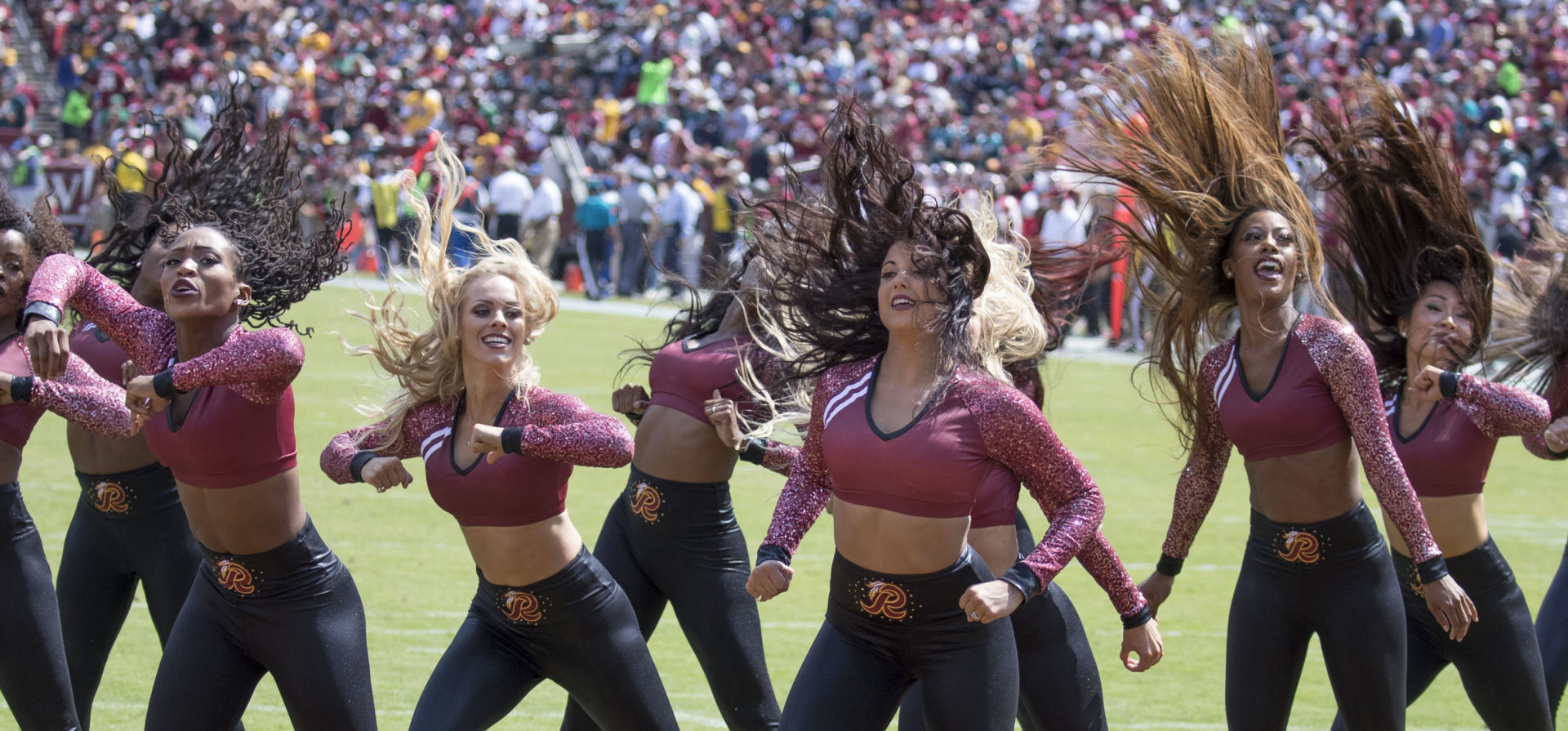

The Washington Redskins cheerleaders have had problems of their own with how they have been treated by management; their situation is not uncommon. | Photo courtesy of Wikimedia Commons/user: SecretName101
Sideline cheerleaders at any sporting event are a staple to the fan experience. They are entertaining at games, but they also spend hours outside of game day practicing and performing at public events to support their team.
At their core, these women are actually not cheerleaders but professional dancers. Most NFL and NBA teams, however, do not pay their dancers a fair wage. Most wages are either below or barely meeting minimum wage.
These women are a fundamental part of the game day atmosphere, and they deserve to be treated as such.
Why it’s allowed
NBA cheerleaders are considered independent contract employees. This means the dancers do not qualify for insurance or health benefits. Since the cheerleaders are contract employees, the teams not required to adhere to federal minimum wage standards.
In the NFL, cheerleaders are required to hold another full-time job in order to dance for the team. This must be because they know their payment is not a livable wage.
While it may be legal to pay them less than minimum wage, the question still remains: Why are professional sports teams OK with the poor treatment of these women who are so important to marketing and fan experience?
NFL revenues have jumped from $4.28 billion in 2001 to $13.16 billion in 2016, reaching record-high amounts. These teams rake in hundreds of millions of dollars from games, marketing and concessions and yet somehow cannot pay these women minimum wage.
It seems to me that teams are so caught up in profits they pay concession stand workers more than their own dancers, who love to dance and cheer for their team so much they spend more than 40 hours a week practicing and performing, on top of holding mandated full-time jobs.
Maybe the answer is simple: Professional sports teams are OK with exploiting women.
Legal action
Dancers from different teams have spoken out and taken legal action against their former employers. The earliest case was brought on by dancers against the NFL Buffalo Bills in 1995. The cheerleaders formed the first ever union, claiming unfair wages and mistreatment by their private owners, Buffalo Jills Cheerleaders Inc.
In 2014, several former Buffalo Jills spoke out for similar reasons, and the company who managed the Jills responded by doing away with the dance team as a whole.
In 2017, legal action was taken by former Milwaukee Bucks dancer Lauren Herington against the team. She sued the team for failing to meet requirements by the U.S. Fair Labor Standards Act as well as Wisconsin’s wage and payment laws.
Herington claimed that dancers spent an average of 30 to 40 hours a week across rehearsals, workouts, public appearances and games. Their payment, however, was set at flat rates: $30 for practice, $50 for special events and $65 for games.
Several Houston Texans cheerleaders tell a similar story. They claim that while they were paid the federal minimum wage of $7.25, they were not compensated for much of their work including travel time, food cost, team social media upkeep and appearances.
The girls specifically cited that their employers were not following the federal Fair Labor Standards Act, which requires that employee pay cannot be below the minimum wage and that employees who work more than 40 hours per week are owed overtime pay rates.
One cheerleader also said her coach claimed cheering was a “part-time job” with “full-time hours,” which seems to be the expectation from other teams as well.
Two former Raiderettes dancing for the Oakland Raiders won a class-action wage theft lawsuit after claiming illegal wage deductions and forced hours of unpaid work. They won a $1.25 million settlement after the Raiders admitted the wrongdoing and in turn forced the team to draw up new contracts promising a $9 an hour wage and overtime, including rehearsals, practices and mandatory appearances.
Emotional, physical mistreatment
On top of unfair wages, dancers are often subject to humiliation and unfair treatment by their coaches and employers. The Texans cheerleaders claim they were regularly physically and emotionally abused and harassed. This alleged harassment ranged from verbal comments about weight to duct taping one cheerleader’s stomach to try and shame her into losing weight.
In 2017, former Miami Dolphins cheerleader Kristan Ware filed a complaint with the Florida Commission on Human Relations, saying she was subjected to a hostile work environment including ridicule of her Christian values and lifestyle. Ware claimed she was a target for harassment when members of her team and her higher-ups found out about her decision to wait until marriage to have sex.
The Washington Redskins had an incident in 2013 when they took their cheerleading squad to the Occidental Grand Papagayo resort in Costa Rica. Several cheerleaders say they were required to pose topless with body paint for a calendar in front of spectators the Redskins invited.
One evening on the trip, nine of the cheerleaders were told they had a special assignment: to be personal escorts for sponsors at a nightclub.
This kind of exploitation was not completely forced, but it was mandatory for them to follow along with these kinds of requests. The Redskins even collected passports from the women upon their arrival at the resort.
Among all of the professional dancers that have spoken out, their stories have one thing in common: There is a great emphasis to the girls that they are replaceable.
Perhaps the teams pay these women so little because they know how many girls would kill to dance on a professional sports team. Anyone who makes trouble can quickly be replaced by someone who will keep quiet about the same treatment.
Best in the world
The players on professional sporting teams are considered the best in their field. The NBA and NFL players are the top of the line. For many dancers, dancing for a professional sports team is the highest position they can hold.
The players are the best in their sport and are paid accordingly. In 2017, the minimum salary for an NBA rookie was a whopping $815,615 and $465,000 for a first-year NFL player.
These dancers are also the best in their field and are paid pathetic wages. Even if some dance teams are independently owned and contracted entities, the NFL and the NBA still use their appearances and talents to market their sports teams. This makes them partly responsible for this kind of treatment.
While these professional dancers may not bring in any specific form of revenue for sports teams, they are a vital part of fan experience and game day atmosphere.
Who would we watch during timeouts? Yet another Jersey Mike’s sandwich ad?
Who else would get the crowd to get on their feet, the mascot alone or the jumbo screen that encourages fans to “make some noise?”
Sideline dancers have been a part of the sports atmosphere for a long time. They have their own fan base and brand, and it is simply unacceptable to treat them as disposable objects working for pennies on the dollar doing something they love.
Professional sports teams simply need to do better.
Opinion columnist Rachel Reynolds is a psychology sophomore and can be reached at opinion@thedailycougar.com.
—
“NFL, NBA dancers deserve fair compensation for their work” was originally posted on The Daily Cougar
